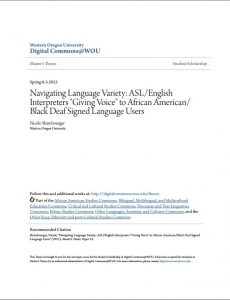Navigating Language Variety: ASL/English Interpreters “Giving Voice” to African American/ Black Deaf Signed Language Users
Abstract
American Sign Language (ASL)/English interpreters working between ASL and spoken English make linguistic and cultural choices that impact the success of an interpreted event. One task is the selection of comparable vocabulary to best represent their clients’ thoughts. This exploratory qualitative study was conducted to identify how ASL/English interpreters transfer meaning when African American English (AAE) is incorporated into signed language. Each interpreter simultaneously interpreted an ASL narrative into spoken English. Participants were asked to complete a demographic survey to ascertain whether social factors of age, race, ethnicity, experience, mode of language ix acquisition, and/or age of language acquisition had any bearing on the interpretation. Following the collection of the interpreting sample and demographic data, two interviews were conducted utilizing a semi-structured format to provide insight into the strategic decisions made by the participants. The findings identify three strategic decisions interpreters used in lieu of incorporating AAE: omission, external processing, and discourse chunking. The overarching purpose was to collect empirical data that will lend itself to dialogues on how to best equip signed language professionals to meet the needs of African American/Black Deaf consumers.
Citation: Shambourger, Nicole, “Navigating Language Variety: ASL/English Interpreters “Giving Voice” to African American/Black Deaf Signed Language Users” (2015). Master’s Theses. Paper 23.










